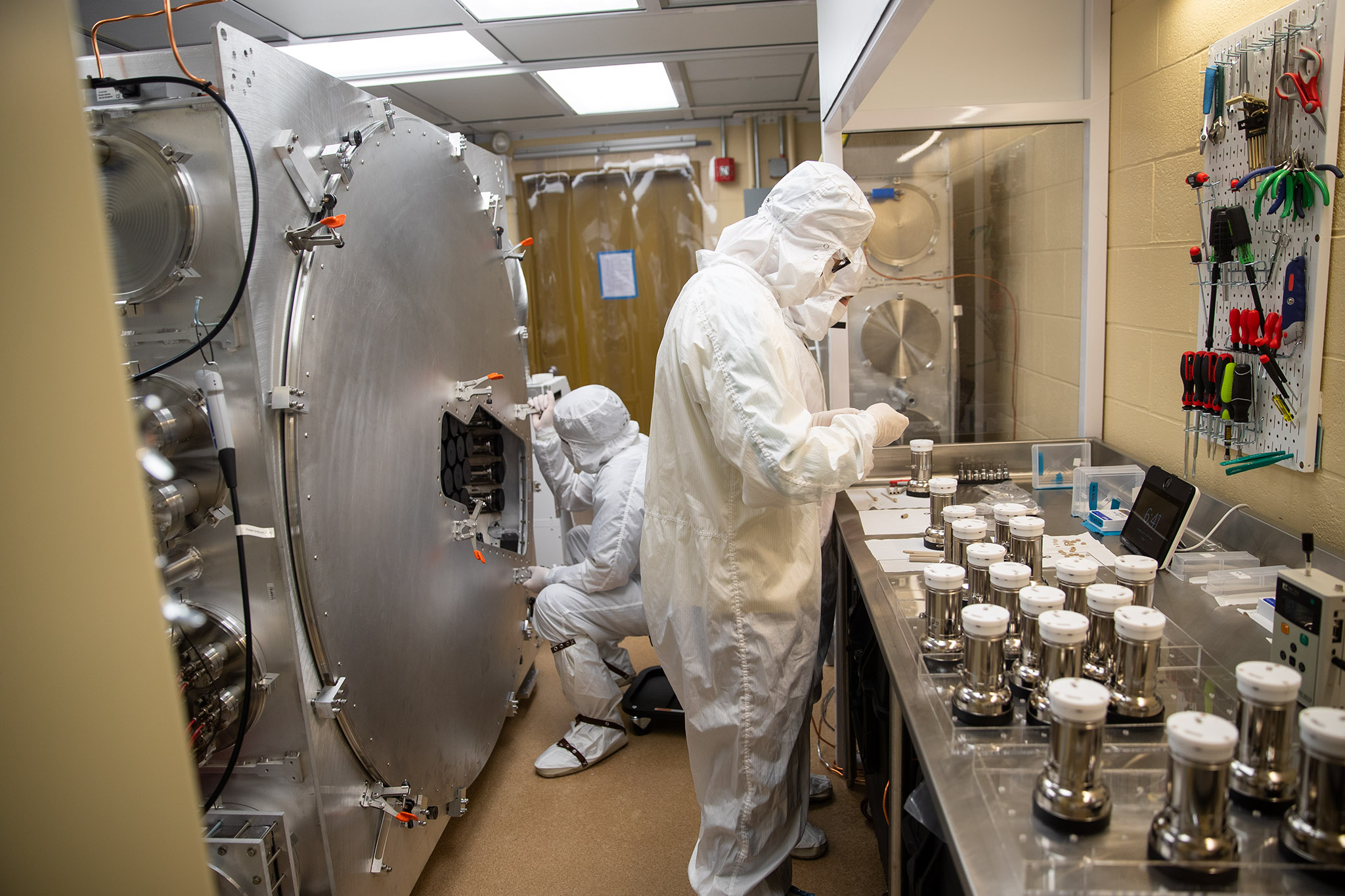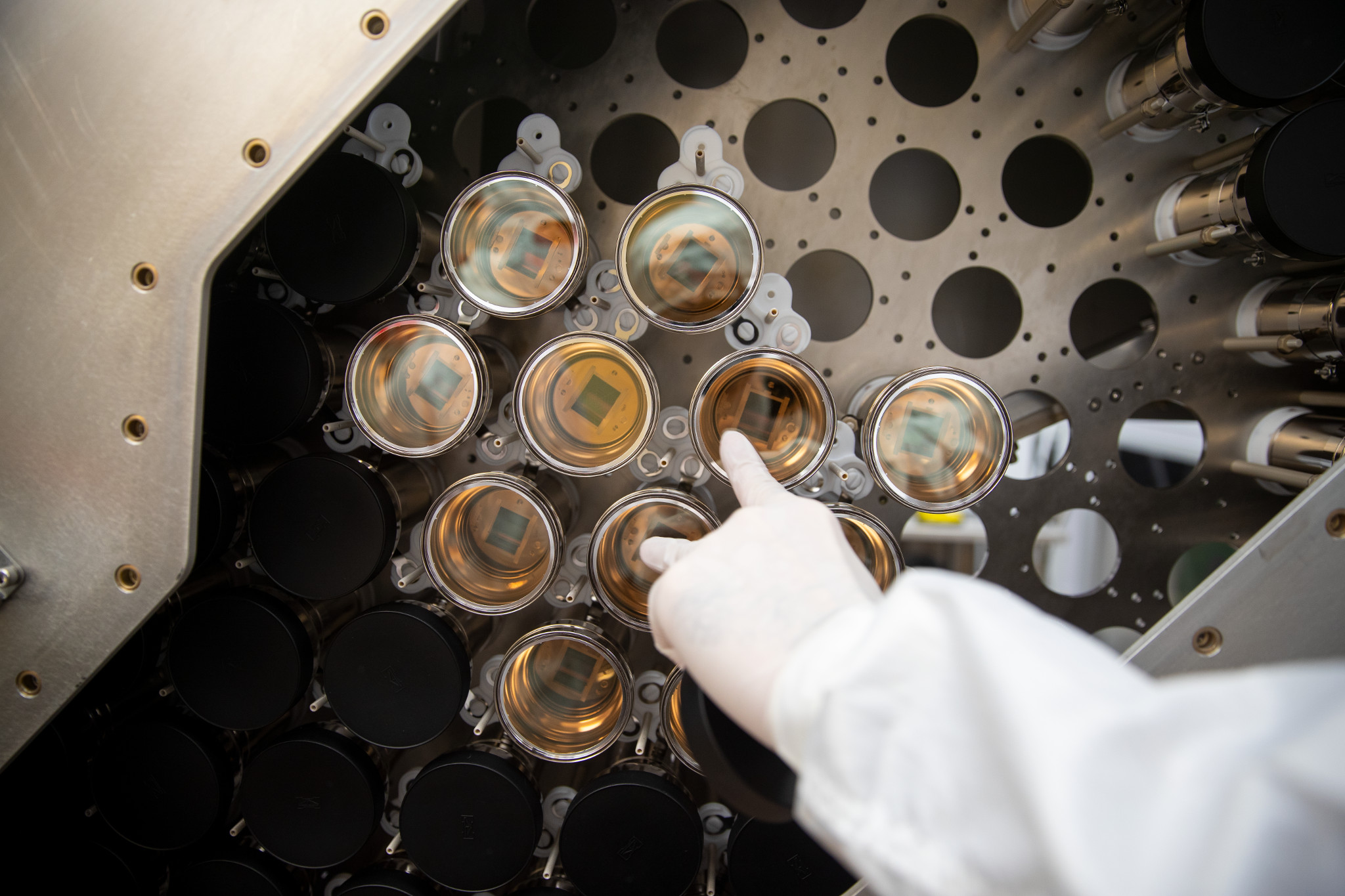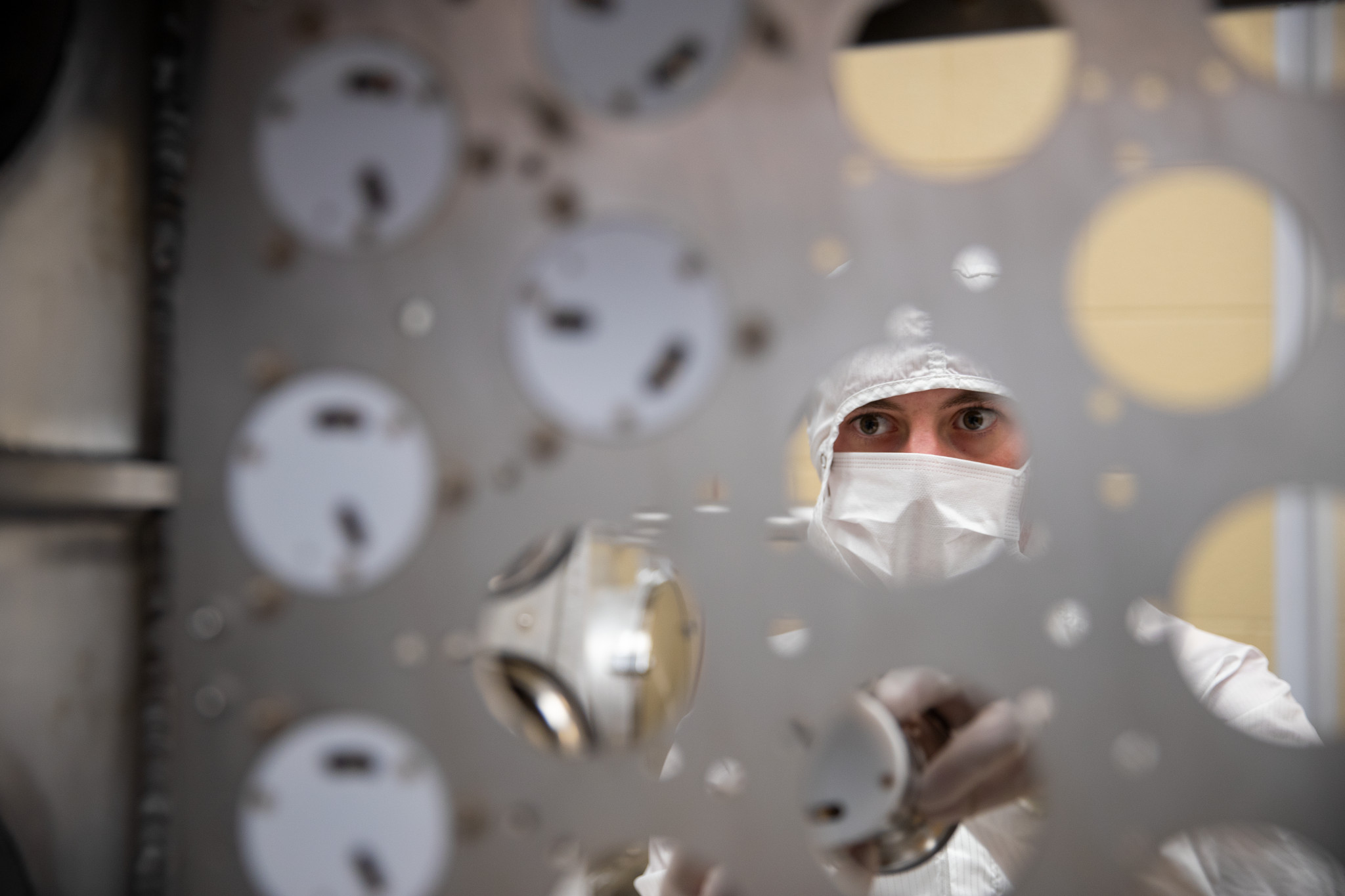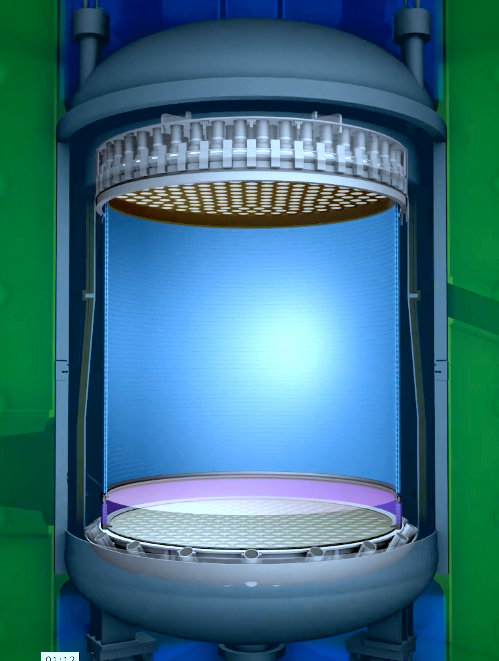
Researchers at Brown University assemble an array of photomultiplier tubes for the LUX-ZEPLIN dark matter search experiment. The first of two photomultiplier arrays, which can detect faint flashes of light from particle interactions, arrived Friday at the Sanford Underground Research Facility in South Dakota. (Credit: Nick Dentamaro/Brown University)
This press release is adapted from a release prepared by Brown University. View the original release.
—by Kevin Stacey
The LUX-ZEPLIN (LZ) dark matter detector, which will soon start its search for the elusive particles thought to account for a majority of matter in the universe, had its first set of “eyes” delivered Thursday.
The first of two large arrays of photomultiplier tubes (PMTs) — powerful light sensors that can detect the faintest of flashes — completed a 2,000-mile journey by truck from Rhode Island to the Sanford Underground Research Facility (SURF) in Lead, South Dakota, where LZ is scheduled to begin its dark matter search in 2020.
The second array will arrive in January. When the LZ detector is completed and switched on, the PMT arrays will keep careful watch on LZ’s 10-ton tank of liquid xenon, looking for the tell-tale twin flashes of light produced if a dark matter particle bumps into a xenon atom inside the tank.

A researcher at Brown University installs photomultiplier tubes for a component of the LUX-ZEPLIN dark matter search experiment. (Credit: Nick Dentamaro/Brown University)
A team of researchers and technicians from Brown University has spent the past six months painstakingly assembling the two arrays, each about 5 feet in diameter and holding a total of 494 PMTs.
“The delivery of these arrays is the pinnacle of an enormous assembly effort that we’ve had to execute here in our clean room,” said Rick Gaitskell, a professor of physics at Brown University who oversaw the construction of the arrays. “For the last two years, we’ve been making sure that every piece that’s going into the devices is working as expected. Only by doing that can we be confident that everything will perform the way we want when the detector is switched on.”
The Brown team has worked with researchers and engineers from the U.S. Department of Energy’s Lawrence Berkeley National Laboratory (Berkeley Lab) and from Imperial College London to design, procure, test, and assemble all of the components of the array. Testing of the PMTs, which are manufactured by the Hamamatsu Corp. in Japan, was performed at Brown and at Imperial College.
“The delivery of the first array of PMTs for LZ to SURF is a critical milestone for the LZ Project,” said Murdock “Gil” Gilchriese of Berkeley Lab, who is the LZ project director.
In preparation for the arrival of the PMT arrays, researchers at SURF had already been working with prototype arrays to practice connecting the PMTs to a complex sequence of cabling. The actual assembly of these cables to the PMTs will take place in a clean room at SURF.
Nobody knows exactly what dark matter is. Scientists can see the effects of its gravity in the rotation of galaxies and in the way light bends as it travels across the universe, but no one has directly detected a dark matter particle. The leading theoretical candidate for a dark matter particle is the WIMP, or weakly interacting massive particle. WIMPs can’t be seen because they don’t absorb, emit, or reflect light. And they interact with normal matter only on very rare occasions, which is why they’re so hard to detect even when millions of them may be traveling through the Earth each second.
The LZ experiment, a collaboration of more than 250 scientists from 38 institutions worldwide, aims to capture one of those fleetingly rare WIMP interactions, and thereby characterize the particles thought to make up more than 80 percent of the matter in the universe. The detector will be the most sensitive ever built: 100 times more sensitive than the LUX detector, which wrapped up its dark matter search at SURF in 2016.

A researcher at Brown University works on a photomultiplier tube array. The tubes are designed to fit into the holes drilled into the metal plate pictured here. (Credit: Nick Dentamaro/Brown University)
The PMT arrays are a critical part of the experiment. Each PMT is a 6-inches-long cylinder that is roughly the diameter of a soda can. To form arrays large enough to monitor the entire LZ xenon target, hundreds of PMTs are assembled together within a circular titanium matrix. The array that will sit on top of the xenon target has 253 PMTs, while the lower array has 241.
PMTs are designed to amplify weak light signals. When individual photons (particles of light) enter a PMT, they strike a photocathode. If the photon has sufficient energy, it causes the photocathode to eject one or more electrons. Those electrons then strike an electrode, which ejects more electrons. By cascading through a series of electrodes the original signal is amplified by over a factor of 1 million to create a detectable signal.
LZ’s PMT arrays will need every bit of that sensitivity to catch the flashes associated with a WIMP interaction.
“We could be looking for events emitting as few as 20 photons in a huge tank containing 10 tons of xenon, which is something that the human visual system wouldn’t be able to do,” Gaitskell said. “But it’s something these arrays can do, and we’ll need them to do it in order to see the signal from rare particle events.”
The photons are produced by what’s known as a nuclear recoil event, which produces two distinct flashes. The first comes at the moment a WIMP bumps into a xenon nucleus. The second, which comes a few hundred microseconds afterward, is produced by the ricochet of the xenon atom that was struck. It bounces into the atoms surrounding it, which knocks a few electrons free. The electrons are then drifted by an electric field to the top of the tank, where they reach a thin layer of xenon gas that converts them into light.

This rendering shows a cutaway view of the LZ xenon tank (center), with PMT arrays at the top and bottom of the tank. (Credit: Greg Stewart/SLAC National Accelerator Laboratory)
In order for those tiny flashes to be distinguishable from unwanted background events, the detector needs to be protected from cosmic rays and other kinds of radiation, which also cause liquid xenon to light up. That’s why the experiment takes place underground at SURF, a former gold mine, where the detector will be shielded by about a mile of rock to limit interference.
The need to limit interference is also the reason that the Brown University team was obsessed with cleanliness while they assembled the arrays. The team’s main enemy was plain old dust.
“When you’re dealing with an instrument that’s as sensitive as LZ, suddenly things you wouldn’t normally care about before become very serious,” said Casey Rhyne, a Brown University graduate student who had a leading role in building the arrays. “One of the biggest challenges we had to confront was minimizing ambient dust levels during assembly.”
Each dust particle carries a miniscule amount of radioactive uranium and thorium decay products. The radiation is vanishingly small and poses no threat to people, but too many of those specks inside the LZ detector could be enough to interfere with a WIMP signal.
In fact, the dust budget for the LZ experiment calls for no more than one gram of dust to be contained in the entire 10-ton instrument. Because of all of their nooks and crannies, the PMT arrays could be significant dust collectors if pains were not taken to keep them clean throughout construction.
The Brown University team performed most of its work in a “class 1000” clean room, which allows no more than 1,000 microscopic dust particles per cubic foot of space. And within that clean room was an even more pristine space that the team dubbed “PALACE (PMT Array Lifting And Commissioning Enclosure).” PALACE was essentially an ultraclean room where much of the actual array assembly took place. PALACE was a “class 10” space — allowing no more than 10 dust particles bigger than 1 hundredth the width of a human hair per cubic foot.
But the radiation concerns didn’t stop at dust. Before assembly of the arrays began, the team prescreened every part of every PMT tube to assess radiation levels.
“We had Hamamatsu send us all of the materials that they were going to use for the PMT construction, and we put them in an underground germanium detector,” said Samuel Chan, a graduate student and PMT system team leader. “This detector is very good at detecting the radiation that the construction materials are emitting. If the intrinsic radiation levels were low enough in these materials, then we told Hamamatsu to go ahead and use them in the manufacture of these PMTs.”
The team is hopeful that all the work they put in over the past six months will pay dividends when LZ starts its WIMP search.
“Getting everything right now will have a huge impact less than two years from now, when we switch on the completed detector and we’re taking data,” Gaitskell said. “We’ll be able to see directly from that data how good of a job we and other people have done.”
Given the major increase in dark matter search sensitivity that the LZ detector can deliver compared to all previous experiments, the team hopes that this detector will finally identify and characterize the vast sea of stuff that surrounds us all. So far, the dark stuff has remained maddeningly elusive.
Major support for LZ comes from the DOE Office of Science’s Office of High Energy Physics, South Dakota Science and Technology Authority, the U.K.’s Science & Technology Facilities Council, and by collaboration members in South Korea and Portugal.
More info:
- VIDEO: The Search for Dark Matter (Credit: Brown University)
- For information about LZ and the LZ collaboration, visit: http://lz.lbl.gov/
- View more photos of the assembly process for the photomultiplier tube arrays (Credit:Nick Dentamaro/Brown University)
###
Lawrence Berkeley National Laboratory addresses the world’s most urgent scientific challenges by advancing sustainable energy, protecting human health, creating new materials, and revealing the origin and fate of the universe. Founded in 1931, Berkeley Lab’s scientific expertise has been recognized with 13 Nobel Prizes. The University of California manages Berkeley Lab for the U.S. Department of Energy’s Office of Science. For more, visit www.lbl.gov.
DOE’s Office of Science is the single largest supporter of basic research in the physical sciences in the United States, and is working to address some of the most pressing challenges of our time. For more information, please visit the Office of Science website at science.energy.gov.
The Sanford Underground Research Facility’s mission is to enable compelling underground, interdisciplinary research in a safe work environment and to inspire our next generation through science, technology, engineering, and math education. For more information, please visit the Sanford Lab website at http://www.sanfordlab.org.